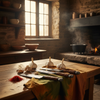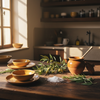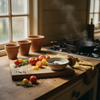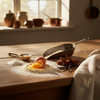How to Cook Steak on Stainless Steel Pan Like a Pro
Key Takeaways
- Cooking steak on a stainless steel pan requires both proper technique and an understanding of the underlying science.
- Having the right tools is essential to achieve a perfect steakhouse crust.
- Confidence in cooking plays a key role in delivering unforgettable steak results.
- Preparation and timing are crucial when guests are arriving soon.
Table of Contents
- The Science & Magic: Why Stainless Steel Is a Steak Game-Changer
- Steak & Pan: Choosing the Best for Sear and Crust
- Preparing Steak for Perfection: Prepping, Salting, Tempering
- Must-Have Equipment and Ingredients: Your Steak Dream Team
- Getting Pan-Ready: The Stainless Steel Preheat Ritual
- Steak Searing Sequence, Crust, Flip, and Sizzle
- Target Temperatures & Doneness, The Steak Thermometer Guide
- Rest, Slice, Serve, Bringing Your Steak to Its Prime
- Flavor Finishers & Upgrades, Compound Butters, Sauces, and Sides
How to Cook Steak on a Stainless Steel Pan Like a Pro Chef: Science, Technique, and Tools for Unforgettable Results
Picture this: You've got a beautiful ribeye, guests arriving in an hour, and the pressure to deliver that perfect steakhouse crust. Sound familiar? Here's the thing, learning how to cook steak on stainless steel pan isn't just about technique; it's about understanding the science, having the right tools, and cooking with confidence.
The secret sauce? It's all in the preheat, the sear, and, here's where most home chefs stumble, using tools that won't melt, scratch, or compromise your food's safety. That's where DI ORO's award-winning, forever-chemical-free spatulas come in. America's Test Kitchen didn't crown our seamless spatula the winner by accident, it's built for moments exactly like these.
For the perfect flip and precise control, kitchen tongs are just as essential as a great spatula. They allow you to maneuver your steak confidently, ensuring even searing and safe handling at high heat.
The Science & Magic: Why Stainless Steel Is a Steak Game-Changer
Ever wonder why steakhouses consistently nail that deep, caramelized crust? It's all about the Maillard reaction, the chemical process that transforms amino acids and sugars into complex, savory compounds when exposed to high heat (above 300°F). Stainless steel excels here because it conducts heat rapidly and evenly, creating the perfect environment for this flavor-building magic.
Unlike coated pans that can release chemicals at high temperatures, stainless steel remains completely non-reactive. This means your garlic, herbs, and seasonings taste exactly as they should, no metallic notes, no chemical interference. The surface also develops what chefs call "fond", those golden-brown bits that become the foundation for incredible pan sauces.
Pro Insight: The slight sticking that happens initially isn't a bug, it's a feature. As proteins cook and release moisture, they naturally release from the pan, taking that beautiful crust with them. This is why how to cook a steak in a pan successfully requires patience and the right spatula to handle the flip without tearing.
This is precisely why DI ORO's seamless silicone spatula matters. Heat-resistant to 600°F and made with pro-grade, forever-chemical-free silicone, it handles the high-heat demands of steak searing while protecting both your pan's surface and your food's integrity. America's Test Kitchen called it "the most versatile silicone spatula on the market" for good reason.
Steak & Pan: Choosing the Best for Sear and Crust

Not all steaks perform equally on stainless steel. The key is matching cut characteristics, marbling, thickness, and texture, to the pan's strengths. Ribeye and New York strip are your best bets, with enough fat content to self-baste and sufficient thickness (1-1.5 inches) to develop crust without overcooking.
| Cut | Marbling | Ideal Thickness | Best Doneness | Stainless Steel Rating |
|---|---|---|---|---|
| Ribeye | High | 1.25-1.5" | Medium-rare | Excellent |
| NY Strip | Medium | 1-1.25" | Medium-rare | Excellent |
| Sirloin | Low-Medium | 1-1.25" | Medium-rare | Good |
| Filet Mignon | Low | 1.5-2" | Medium-rare | Good |
For your stainless steel pan, look for fully-clad construction (not just a thick bottom) to ensure even heat distribution. A 10-12 inch pan gives steaks room to breathe, preventing steam buildup that kills crust formation. The pan should feel substantial, lightweight pans create hot spots that lead to uneven cooking.
If you're interested in more tips for mastering stainless cookware, check out this guide on how to cook with stainless steel for broader techniques and troubleshooting advice.
Preparing Steak for Perfection: Prepping, Salting, Tempering
The difference between amateur and pro results happens before the steak ever hits the pan. Start by patting your steak completely dry with paper towels, twice. Moisture is the enemy of crust formation, creating steam that prevents the Maillard reaction from taking hold.
Salt timing determines flavor depth. For immediate cooking, season generously right before the pan, this creates a clean, classic crust. For deeper flavor, try dry brining: salt your steak and let it rest uncovered in the refrigerator for 40 minutes to overnight. The salt initially draws out moisture, then reabsorbs it along with broken-down proteins, creating a more concentrated, tender result.
Critical Timing: Never salt between 10-30 minutes before cooking. This creates the worst of both worlds, drawn-out moisture without enough time for reabsorption, resulting in a gray, steamed exterior.
Remove your steak from the fridge 20-40 minutes before cooking to bring it closer to room temperature. This promotes even cooking from edge to center. Just before searing, brush both sides lightly with neutral, high-smoke-point oil like avocado or grapeseed, about 1 teaspoon per steak ensures immediate sizzle contact with the pan.
Must-Have Equipment and Ingredients: Your Steak Dream Team
Success in how to cook steak on stainless steel pan comes down to having the right tools for each critical moment. A heavy-bottomed, 10-12 inch stainless steel pan provides even heat distribution, while kitchen tongs give you precise control for flipping and positioning.
| Tool | Purpose | Why DI ORO Excels |
|---|---|---|
| Seamless Spatula | Scraping fond, basting, cleanup | 600°F heat resistance, forever-chemical-free |
| Silicone-Tipped Tongs | Flipping, edge-searing | Won't scratch pan surface |
| Instant-Read Thermometer | Precise doneness | Eliminates guesswork |
The America's Test Kitchen award-winning DI ORO spatula isn't just marketing hype, it's engineered for exactly these high-heat moments. Pro-grade silicone withstands the 400-500°F temperatures needed for proper searing, while the seamless design prevents bacteria buildup and makes cleanup effortless.
Essential ingredients include high-smoke-point oil (avocado, grapeseed), unsalted butter for finishing, fresh garlic cloves, and hardy herbs like rosemary or thyme that won't burn during the final basting stage.
Getting Pan-Ready: The Stainless Steel Preheat Ritual

Most home steak failures trace back to improper preheating. Start your stainless steel pan on low heat for 5-7 minutes, this gradual warmup creates an evenly heated surface without hot spots. Then increase to medium-high for the final minute before adding oil.
The water droplet test eliminates guesswork: flick 1/2 teaspoon of water into the pan. If it beads up and dances across the surface, you've hit the sweet spot. If it sizzles and evaporates immediately, the pan is too hot. If it just sits there, keep heating.
Pro Timing: Add oil only when the pan reaches proper temperature, then watch for a shimmer, not smoke. This creates a natural non-stick barrier that maximizes crust formation while preventing sticking.
Swirl the oil to coat the entire surface for 10 seconds. The oil should move freely and shimmer but never smoke. This superheated oil layer becomes your steak's first contact point, initiating the Maillard reaction instantly upon contact.
Steak Searing Sequence, Crust, Flip, and Sizzle
When learning how to cook steak on stainless steel pan, timing and technique converge in these critical moments. Lay your steak gently in the center of the pan, always placing it away from your body to avoid oil splatter. You should hear an immediate, aggressive sizzle, silence means your pan wasn't hot enough.
Resist the urge to move, peek, or adjust for 2-3 minutes. This undisturbed contact time allows proteins to coagulate and naturally release from the pan surface, bringing the developing crust with them. For even cooking and maximum crust development, flip every 45-60 seconds after this initial sear, contrary to the "flip once" myth, frequent flipping actually produces more even results.
Use your DI ORO seamless spatula or tongs to stand the steak on its fatty edges for 30 seconds each side, rendering the fat and creating additional caramelization. During the final 1-2 minutes, lower heat to medium and add 2 tablespoons of butter, a smashed garlic clove, and fresh rosemary or thyme. Tilt the pan and use your DI ORO seamless spatula to baste the foaming butter over the steak repeatedly, this French technique called "arroser" infuses incredible flavor while enhancing the crust.
The key is patience during searing. Resist the urge to move or peek under the steak for the first 2-3 minutes. You'll hear the sizzle intensify, then slightly calm, that's your cue that a proper crust is forming. When you do flip (and every 45-60 seconds after), use confident, quick motions with tongs or your spatula to maintain that high-heat environment.
Pro Timing: For a 1.25-inch ribeye, expect 3-4 minutes per side for medium-rare. Thicker cuts benefit from the reverse-sear method, start in a 275°F oven until 10°F below target temp, then finish with a blazing-hot sear.
If you want to see another approach, this guide on cooking steak in stainless steel pan offers additional step-by-step tips and troubleshooting for home cooks.
Target Temperatures & Doneness, The Steak Thermometer Guide
Guesswork has no place in perfect steak execution. Even seasoned chefs rely on instant-read thermometers because how to cook steak on stainless steel pan success hinges on precision, not luck.
| Doneness Level | Target Internal Temp | Remove from Heat At | Texture & Color |
|---|---|---|---|
| Rare | 125°F | 120°F | Cool red center, very soft |
| Medium-Rare | 135°F | 130°F | Warm red center, yielding |
| Medium | 145°F | 140°F | Pink center, firm but juicy |
| Medium-Well | 150°F | 145°F | Slight pink, firmer texture |
| Well-Done | 160°F | 155°F | No pink, fully cooked through |
Insert your thermometer horizontally into the thickest part of the steak, avoiding contact with the pan. The 5-10°F carryover cooking during rest time is crucial, your steak continues cooking from residual heat even after leaving the pan.
For beginners, medium-rare delivers the perfect balance of safety, flavor, and tenderness. The warm red center stays incredibly juicy while the exterior develops that coveted steakhouse crust. For more information on proper steak temperatures, see this USDA guide to steak doneness.
Rest, Slice, Serve, Bringing Your Steak to Its Prime

Resting isn't optional, it's the difference between a puddle of juices on your plate and a perfectly moist, tender bite. Transfer your seared steak to a wire rack or plate and tent loosely with foil for 5-10 minutes.
During this crucial window, muscle fibers relax and redistribute their juices throughout the meat. Skip this step, and you'll watch your steak's flavorful essence pool around your plate instead of staying where it belongs.
When ready to serve, always slice against the grain, look for the direction of muscle fibers and cut perpendicular to them. This breaks down tough connective tissue, ensuring each bite is tender regardless of the cut you chose.
Drizzle any remaining pan juices over the sliced steak, or finish with a pat of compound butter. The contrast between the caramelized exterior and juicy interior, enhanced by those rich pan flavors, transforms a simple steak in stainless steel pan into a restaurant-worthy masterpiece.
Flavor Finishers & Upgrades, Compound Butters, Sauces, and Sides
Elevate your steak from excellent to unforgettable with these simple finishing touches that showcase why learning how to cook steak on stainless steel pan opens up endless flavor possibilities.
Compound Butter Classics: Mix 4 tablespoons softened butter with minced garlic and fresh parsley, or try blue cheese and chives for bold flavor. Roll in parchment paper and chill, you'll have steakhouse-quality finishing butter ready for any occasion.
The beauty of stainless steel shines in pan sauce creation. After removing your steak, add ¼ cup red wine or beef stock to the hot pan. Use your DI ORO seamless spatula to scrape up all those caramelized bits (the fond), simmer for 2 minutes, then swirl in cold butter for a glossy, restaurant-quality sauce.
For sides that complement without competing, sauté mushrooms in the same pan after deglazing, or quickly wilt spinach with garlic. The residual steak flavors in your pan transform simple vegetables into sophisticated accompaniments. For a scientific look at the Maillard reaction and flavor development, see this ScienceDirect article on meat browning.
If you want to master other stainless steel cooking techniques, you might also enjoy this guide on how to cook eggs on stainless steel for breakfast perfection.
Troubleshooting & Steak Problems: Real-World Fixes
Frequently Asked Questions
Why is stainless steel considered the best pan material for achieving a perfect steak crust?
Stainless steel pans conduct heat rapidly and evenly, creating the high temperatures needed for the Maillard reaction, which forms that coveted steakhouse crust. Unlike coated pans, stainless steel is non-reactive, preserving the true flavors of your steak and seasonings while developing flavorful fond for sauces.
What are the essential tools needed to cook steak successfully on a stainless steel pan?
Key tools include a high-quality stainless steel pan for even heat, a reliable pair of kitchen tongs for safe and precise handling, and DI ORO’s award-winning, forever-chemical-free silicone spatulas for flipping and scraping without scratching or melting. A meat thermometer is also essential to nail the perfect doneness.
How does the Maillard reaction contribute to the flavor and crust development when cooking steak?
The Maillard reaction is a chemical process where amino acids and sugars in the steak react at high heat (above 300°F), creating complex, savory flavors and a rich, caramelized crust. This reaction is what transforms a simple sear into a deeply flavorful, steakhouse-quality crust.
What is the proper technique for searing and flipping steak on a stainless steel pan to avoid sticking or tearing?
Preheat the pan until it’s shimmering, then add high smoke-point oil before placing the steak down without moving it to allow a crust to form. Flip the steak only once using tongs or a spatula designed for high heat, like DI ORO’s seamless spatula, to prevent sticking or tearing and ensure even searing.



